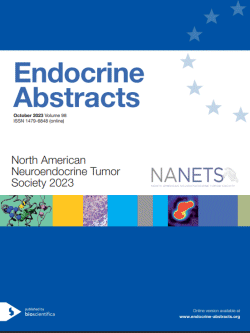Abstracts
Clinical – Chemo/SSA/Biologics
ea0098c1 | Clinical – Chemo/SSA/Biologics | NANETS2023
Clinical impact of unsuccessful subcutaneous administration of octreotide LAR instead of intramuscular administration in patients living with metastatic neuroendocrine tumors
Krishnan Tharani , Safro Maria , Moreira Furlanetto Daniel , Gill Sharlene , Paulo Solar Vasconcelos Joao , Stuart Heather C. , Martineau Patrick , Loree Jonathan M.
ea0098c2 | Clinical – Chemo/SSA/Biologics | NANETS2023
Neuroendocrine tumor metastatic to breast: case report and review of the literature
Augusto Urrego Jose , Gonzalez Diaz Marcela , Ernesto Romero-Rojas Alfredo , Strosberg Jonathan , Jimenez Vasquez Paola
ea0098c3 | Clinical – Chemo/SSA/Biologics | NANETS2023
Real-world evidence of lenvatinib use for treatment of metastatic neuroendocrine neoplasms
Paulo Solar Vasconcelos Joao , Eduardo Nunez Rodrigues Jose , Zaidi Ali , Jafari Helia , Krishnan Tharani , Gill Sharlene , Tan Ann , Le Dan , Chan Theresa , Yu Simon , Paul McGhie John , Lim Howard , Singh Simron , Michael Loree Jonathan
ea0098c4 | Clinical – Chemo/SSA/Biologics | NANETS2023
Results from a Phase II study of nanoliposomal irinotecan (nal-IRI) with 5-fluorouracil (5-FU)/leucovorin in refractory advanced high-grade neuroendocrine cancer (HG-NEC)
Mukherjee Sarbajit , Ramirez Robert , Fountzilas Christos , Vadehra Deepak , Lynne Tarquini Mary , Attwood Kristopher , Iyer Renuka
ea0098c5 | Clinical – Chemo/SSA/Biologics | NANETS2023
A phase 2 clinical trial of cabozantinib in patients with unresectable and progressive metastatic pheochromocytoma or paraganglioma: The NATALIE trial
Jimenez Camilo , Habra Mouhammed A. , Campbell Matthew T. , Tamsen Gina , Cruz-Goldberg Damaris , Long James , Bassett Roland , Dantzer Robert , Balderrama Vania , Varghese Jeena , Waguespack Steven , Lu Yang
ea0098c6 | Clinical – Chemo/SSA/Biologics | NANETS2023
The role of somatostatin analogue maintenance therapy in refractory metastatic neuroendocrine tumors (NETs): comparative analysis
Mohamed A. , Kurian M. , Patil S. , Asa S.L. , Tirumani S.H. , Mahipal A. , Bajor D. , Chakrabarti S. , Selfridge J.E. , Ocuin L.M. , Hoehn R.S. , Winter J. , Ammori J. , Hardacre J. , Henke L.E. , Bahar L.
ea0098c7 | Clinical – Chemo/SSA/Biologics | NANETS2023
A phase II clinical trial of nivolumab and temozolomide for neuroendocrine neoplasms (NEN): updated overall survival data
Owen Dwight H. , Sukrithan Vineeth , Benner Brooke , Wei Lai , Goyal Ashima , Zhou Ye , Pilcher Carly , Curtis Nancy , Jukich Megan , Schwarz Emily , Savardekar Himanshu , Norman Ruthann , Ferguson Sarah , Kleiber Barbara , Wesolowski Robert , Carson William E. , Gregory A. Otterson III, , Verschraegen Claire F. , Shah Manisha H. , Konda Bhavana
ea0098c8 | Clinical – Chemo/SSA/Biologics | NANETS2023
Effect of hepatic impairment on pharmacokinetics, safety, and tolerability of oral paltusotine, a small-molecule, selective somatostatin receptor subtype 2 agonist
Luo MS Rosa , Casagrande MD, PhD Alessandra , Oun BA Sonic , Wang MSPH Yang , Scott Struthers PhD R. , Usiskin MD Keith , Krasner MD Alan
ea0098c9 | Clinical – Chemo/SSA/Biologics | NANETS2023
Anti-apoptosis as a therapeutic strategy in Neuroendocrine neoplasms (NEN): A case report
Sukrithan, MD Vineeth K. , Ahmed Uzair , Zhou Ye , Rogers MD Kerry A. , Konda, MD, MPH Bhavana
ea0098c10 | Clinical – Chemo/SSA/Biologics | NANETS2023
An ongoing phase I trial of the DLL3/CD3 IgG-like T-cell engager, BI 764532, in patients with DLL3-positive extrapulmonary neuroendocrine carcinomas
Gambardella Valentina , Capdevila Jaume , Kuboki Yasutoshi , B Alese Olatunji , Morgensztern Daniel , Sayehli Cyrus , F Sanmamed Miguel , Arriola Edurne , Wolf Jurgen , Owonikoko Taofeek , Bouzaggou Mohamed , Song Eric , Studeny Matus , Wermke Martin
ea0098c11 | Clinical – Chemo/SSA/Biologics | NANETS2023
Transformation of low-intermediate grade neuroendocrine tumors into high grade morphology
McGlothlin, MD John D. , Dilmaghani, MD Saam , Hazim, MD Antonious Z. , Hobday, MD Timothy J. , Sonbol, MD Mohamad B. , Starr, DO Jason S. , Eiring, PA-C Rachel A. , Graham MBBS Rondell P. , Halfdanarson, MD Thorvardur R.
ea0098c12 | Clinical – Chemo/SSA/Biologics | NANETS2023
Real world use of virtual care for treatment of gastroenteropancreatic neuroendocrine tumors (GEP-NETs)
J Phillips William , Pradier Michelle , Goodwin Rachel , Vickers Michael , Asmis Tim
ea0098c13 | Clinical – Chemo/SSA/Biologics | NANETS2023
Clinical characteristics and molecular profiling of patients with pancreatic mixed acinar-neuroendocrine carcinoma
Eslinger Cody , Seddighzadeh Bobak , Elsabbagh Zaid , Pai Rish , Hartley Chris , Starr Jason , Bekaii-Saab Tanios , Halfdanarson Thorvardur , Bassam Sonbol Mohamad
ea0098c14 | Clinical – Chemo/SSA/Biologics | NANETS2023
Cabozantinib as salvage therapy for well differentiated grade 3 neuroendocrine tumors (G3 NETs)
Schnell Rylie R. , Eiring Rachel A. , Miller Morgan C. , McGarrah Patrick W. , Halfdanarson Thorvardur R.
ea0098c15 | Clinical – Chemo/SSA/Biologics | NANETS2023
Phase II study of frontline maintenance rucaparib in combination with nivolumab in extensive stage small cell lung cancer
Chauhan Aman , Kolesar Jill , Yan Donglin , Hao Zhonglin , McGarry Ronald , Villano John , Zinner Ralph , Maskey Ashish , Miller Jordan , Mullett Timothy , Khurana Aman , Zhou Xitong , Gupta Garima , Flora Daniel , Darnell Colleen , O'Neil Richard , Kunos Charles , Anthony Lowell , Arnold Susanne
ea0098c16 | Clinical – Chemo/SSA/Biologics | NANETS2023
Comparison of well-differentiated gastroenteropancreatic grade 3 neuroendocrine tumors (G3NETS): de novo and in the setting of apparent grade progression over time
Khuong Le Bryan , Paciorek Alan , Moon Farhana , Lawhn Heath Courtney , Hope Thomas , Fidelman Nicholas , Mulvey Claire , Lindsay Sheila , Zhang¬ Li , Nakakura Eric , Joseph Nancy , Bergsland Emily K.
ea0098c17 | Clinical – Chemo/SSA/Biologics | NANETS2023
Argentinian registry of gastric neuroendocrine tumors: A closer look at type 1
Oviedo Ana , Luca Romina , Bestani Claudia , Rodriguez Andres , Waisberg Federico , Ypa Carla , Catani Greta , Acosta Andrea , Maquieira Julian , Pombo Teresa , Kujaruk Mirta , Mendez Guillermo , O'Connor Juan




